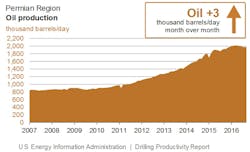EIA: Permian oil output to rise 3,000 b/d in September
The Permian held out roughly a year before joining the other major US shale regions in crude-oil production declines during the current downturn. Now, after a string of losses, growth from the West Texas and southeastern New Mexico basin is expected again by the US Energy Information Administration.
EIA’s Drilling Productivity Report (DPR) projects output from the Permian to rise 3,000 b/d to 1.977 million b/d during September, representing the only major shale region forecast to increase.
In addition to the Permian, the DPR focuses on the Bakken, Eagle Ford, Haynesville, Marcellus, Niobrara, and Utica regions, which altogether accounted for 95% of US crude production increases and all US natural gas production increases during 2011-13.
The seven regions are collectively forecast to fall 85,000 b/d to 4.47 million b/d during September. Consistent with other expected monthly increases in past DPRs, the bulk of the overall decline is expected to come from the Eagle Ford, which is seen dropping 53,000 b/d to 1.026 million b/d.
Falling further beneath the 1 million-b/d benchmark, the Bakken is expected to decrease 26,000 b/d to 942,000 b/d (OGJ Online, July 18, 2016). The Niobrara is seen losing 7,000 b/d to 370,000 b/d.
An outcome of more efficient drilling operations, new-well oil production/rig across the seven regions is projected to increase in September by a rig-weighted average of 18 b/d to 578 b/d. The Niobrara is to lead the way with a 21-b/d jump to 982 b/d, followed by an 18-b/d rise to 875 b/d in the Bakken and a 13-b/d bump to 1.089 in the Eagle Ford.
EIA anticipates September shale gas production from the regions to drop 373 MMcfd to 45.45 bcfd, with the Eagle Ford losing 212 MMcfd to 5.594 bcfd, Niobrara down 69 MMcfd to 4.113 bcfd, Haynesville decreasing 36 MMcfd to 5.844 bcfd, Marcellus declining 33 MMcfd to 17.81 bcfd, and Bakken relinquishing 27 MMcfd to 1.543 bcfd. The Utica, meanwhile, is expected to rise 9 MMcfd to 3.683 bcfd.

